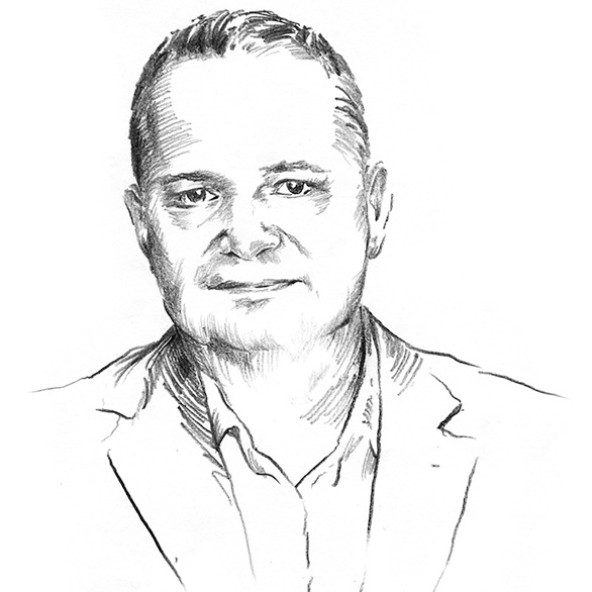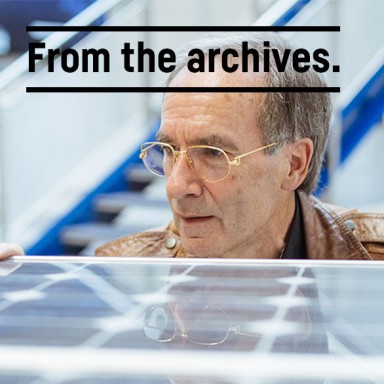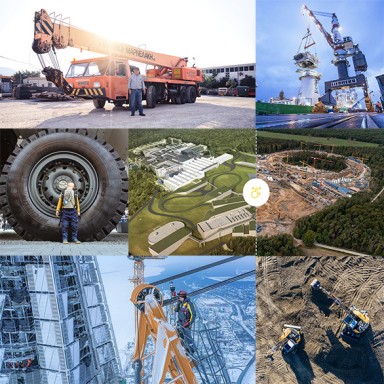
8 minutes reading time
One topic, three industries: the present and future of cooling
What does a freezer, an airplane cabin and a charging cable of an electric car have in common? None of them would function without cooling. Cooling and air-conditioning are hot topics at Liebherr. Demand for reliable air-conditioning is growing worldwide – whether for comfort or as a technical requirement. Cooling systems is a large market. So we decided to sit down with three experts from different areas within our Group to learn more about it.
“Nothing is greener than air.”
What is the current state of cooling technologies and what does the future hold? Are there overarching trends and challenges? Three Liebherr experts, all of whom work in research and development, but in completely different product segments, share their knowledge and insights: Thomas Obererlacher from the refrigeration and freezing appliances segment, Laurent Hartenstein from aerospace and Reinhard Aigner from transportation systems.

Reinhard Aigner, Transportation Systems
1
Let's get started straight away with transportation systems. Mr. Aigner – whether it is trains, trams or the metro. What are current cooling solutions like?
Reinhard Aigner: Cooling is based on the principle of a vapor-compression refrigeration system. Synthetic refrigerants are still the most frequently used option. However, depending on the area of application we also work with CO2 or air as the refrigerant.
Our customers in the transportation industry are, with a few exceptions, rather traditional in the refrigerants they use. Technologies only become established if there is sufficient demand for them. The pressure to change comes particularly from institutions, for example, the F-gas Regulation of the European Union. Air-conditioning units with air circulation on the ICE3 of the Deutsche Bahn were introduced. Consequently, we have now received our first order for air-conditioning units with CO2 as refrigerant on trains from the ÖBB, the Austrian national railway system, for instance.
The general trend in air-conditioning is clearly heading towards the use of CO2, air, or other natural gases with minimal global warming potential. For instance, the refrigeration and freezing segment uses propane and butane in their cooling circuits. However, these substances have a significant disadvantage when used in the quantities required for the transportation industry: they are highly combustible.
2
Refrigeration and freezing are a good segue into the next topic. Mr. Obererlacher, what is different with refrigerators – especially in terms of technology?
Thomas Obererlacher: Compared to other industries, our cooling technology is already quite green as we use electricity for cooling and the energy consumption has been greatly reduced over the last few years. We are intensively working on making cooling technology even more efficient and therefore more sustainable for now and for the future. People have been talking about ‘new cooling technologies’ for some time now. However, it remains to be seen whether these technologies will become established in the long term.
We are focusing on the ideal storage conditions for every food.
3
What do you understand by ‘new cooling technologies’?
Thomas Obererlacher: Examples of new technologies include the so-called calorific processes. These cooling systems do not require a compressor or refrigerant. In these processes, a suitable calorically sensitive material is subjected to a cyclically changing field – this can be magnetic, electrical, or mechanical – which causes a temperature change that can be used for cooling. We are keeping a close eye on these technologies. However, its use only makes sense if significant advantages arise in terms of energy consumption and sustainability. In the Liebherr refrigeration and freezing appliance segment, we already recognized many other innovations as being more attractive in a timely manner.
For example, we are focusing on the ideal storage conditions for every food. We are continuously working on new solutions, such as our BioFresh technology, for storing food at optimal conditions to extend its shelf life and play a part in reducing food waste. Another example is our BioFresh Professional with the brand new HydroBreeze feature, which produces a cold fresh mist each time the door is opened.
Another important focal point is the use of intelligent new materials and components to produce sustainable products, as well as digitalization.

Thomas Obererlacher, Refrigeration and Freezing
4
What effects does digitalization have on cooling?
Thomas Obererlacher: One thing is clear – Smart technology is the way of the future! For some time now, cooling units have required more than just basic air-conditioning. We rather talk about the optimal storage climate for perfect freshness. Customers will be able to go shopping less often and their appliances will keep their goods fresh for much longer, resulting in less waste and more efficiency. This should be the standard we all strive for.
You might be asking yourself what does this have to do with digitalization? Here is an example of what this could look like in the future: Let’s suppose someone always does their main food shopping on Saturday mornings. The appliance will detect this behavior via its intelligent sensors. The findings it obtains will be converted into optimal control of the unit by a special control algorithm. In this example, it means that the unit will use the renewable, cheaper off-peak electricity from Friday to Saturday to control the temperature so that it is below the target value. Then, when a lot of fresh produce is put in the fridge after the user goes food shopping, sufficient inexpensive cool air is already available. A significant temperature increase caused by a lot of fresh produce is therefore avoided. The unit does not go into ‘stress mode’ and the food is exposed to fewer detrimental temperature fluctuations. The result: The goods stay fresher for longer thanks to the intelligent use of cooling paired with greater efficiency.
5
You mentioned efficiency, which leads us on to the aerospace industry: Mr. Hartenstein, what role does efficient cooling play in the aerospace industry?
Laurent Hartenstein: If we look at modern air transportation, efficiency does not only lie in cooling performance. Energy efficient systems shall cater for air-conditioning, air quality and comfortable cabin pressure functions as well.
The aerospace industry has always been an energy-intensive business. Technologies in the aerospace industry are continuously evolving, driven by economic and environmental factors. To make ‘greener’ aircraft, sustainable solutions are now a must. Reducing the footprint of the aerospace industry on the environment – by reducing fuel consumptions or enabling ‘greener’ fuel solutions – has become a great priority.
To make ‘greener’ aircraft, sustainable solutions are now a must.
6
And which specific technologies are used at Liebherr-Aerospace?
Laurent Hartenstein: The air-conditioning system is one of the largest energy consumers on board of a passenger airplane. Two to three percent of the engine power is used to air-condition the airplane cabin. This is equal to around one kilowatt for every passenger. Making this function more efficient is therefore a key differentiator that needs to be pursued to offer best in class products.
Our challenge is to maintain technological advances in the wide range of products we offer to support the needs of our market. This requires innovative technology measures in many fields: From vapor compression cycles to turbomachinery. Vapor compression cycles, also used in the refrigeration and freezing appliances segment, represent ten percent of the market for ‘small’ carriers. Whereas turbomachinery – which uses air itself as the cooling media – accounts for ninety percent of the market for systems. Nothing is greener than air when it comes to the greenhouse effect!
One of the main technological changes that can be noted in this quest for efficiency is the change in air systems. Conventional systems use air extracted from high pressure compression stages of the engines and process it to meet adequate comfort in the cabin. This entails a significant waste of energy in the process. That’s why we are introducing an innovative system using ambient air. This system takes ‘just’ the necessary energy to bring it to the cabin. It has the advantage of drastically reducing the power consumption for the function and is always ensuring the highest possible quality of air supply for the passengers.

Laurent Hartenstein, Aerospace
7
What potential do you see in fuel cells and electric drives?
Laurent Hartenstein: These technologies are a major step beyond the conventional airplane and require new airplane and possibly propulsion systems concepts. They represent full or partial alternatives to the use of fossil fuel. That’s why they are thoroughly investigated in order to drastically reduce the environmental footprint of aviation.
Fuel cells are already in use in stationery and automotive applications. Mastering fuel cell cooling is clearly a catalyst for this technology to be fully adapted in aerospace applications. This is an advantage for us.
Preparations for these future activities have already begun: At system level through our knowledge of integrated airborne cooling systems and key core products used, such as motorized turbomachines and heat exchangers.
8
Mr. Aigner, the situation in traffic engineering is different. Electric mobility and fuel cells are no longer a futuristic vision. How is Liebherr getting involved?
Reinhard Aigner: We are already playing a part when it comes to cooling in the context of electric mobility – with rapid charging stations for electric cars or battery cooling of battery-powered bus or railway vehicles. Faster charging of electric cars will be possible using higher voltage and current. With thermal conditioning units, the cables and plugs used for charging on these rapid charging stations are cooled with a fluid to significantly reduce the charging time.
The charge capacity must also be further increased in the future as electric mobility becomes more widespread. In parallel to this, charging should also be made more convenient, for example, through an inductive charging process – in other words, wireless charging. The inductive charging station may need a cooling unit for an efficient and rapid charging process and our cooling systems could play an important role here too.
The development of cooling technologies is driving major changes in the way people behave.
9
As you can see, cooling and air-conditioning are and will remain a very diverse and extensive field for Liebherr. Is there any way you could summarize the parallels amongst these individual fields?
Laurent Hartenstein: I see the cooling technologies first and foremost as ‘something that empowers people’. The development of cooling technologies is driving major changes in the way people behave. This applies to all areas where Liebherr is involved in cooling:
The invention of the refrigerator and the technology behind it introduced a complete change in the way people live and interact with food – what products they consume and have access to, how they consume it, and so on.
The situation in the aerospace industry is similar: Until the 1940s, the only way to have cabin environment – meaning pressure and temperature – compatible with passengers, was to fly at low altitude. A flight from Munich to New York required over 20 hours and several stops and could only carry 30 passengers! The invention of a conditioned, pressurized cabin and the technology behind it, has drastically changed the travel capabilities and costs of aviation. This makes long haul flights accessible to many more people across different time zones.
What drives all of us at Liebherr is the ambition to push technological progress. We continuously make investments to further develop our products so that we can offer solutions for the challenges of our times.



